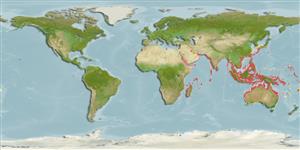Common names from other countries
Environment: milieu / climate zone / depth range / distribution range
Écologie
; profondeur 0 - 20 m (Ref. 348), usually 0 - 20 m (Ref. 75831). Tropical
Distribution
Pays | Zones FAO | Écosystèmes | Occurrences | Introductions
Indo-West Pacific: from East and South Africa to the Philippines; north to Japan and south to Malaysia.
Length at first maturity / Taille / Poids / Âge
Maturity: Lm ? range ? - ? cm Max length : 4.5 cm SHL mâle / non sexé; (Ref. 348); common length : 3.5 cm SHL mâle / non sexé; (Ref. 348)
Intertidal to subtidal, on sand (Ref. 75840). Discretely motile suspension feeder (Ref. 125928). Shallow burrower (Ref. 126187).
Life cycle and mating behavior
Maturité | Reproduction | Frai | Œufs | Fécondité | Larves
Members of the class Bivalvia are mostly gonochoric, some are protandric hermaphrodites. Life cycle: Embryos develop into free-swimming trocophore larvae, succeeded by the bivalve veliger, resembling a miniature clam.
Poutiers, J.M. 1998. (Ref. 348)
Statut dans la liste rouge de l'IUCN (Ref. 130435)
statut CITES (Ref. 108899)
Not Evaluated
Not Evaluated
Menace pour l'homme
Harmless
Utilisations par l'homme
| FishSource |
Outils
Plus d'informations
Taille/ÂgeCroissanceLongueur-poidsLongueur-longueurMorphologieLarvesAbondance
Sources Internet
Estimates based on models
Preferred temperature
(Ref.
115969): 22.1 - 29.1, mean 28.1 (based on 1502 cells).
Vulnérabilité
Low vulnerability (10 of 100).
